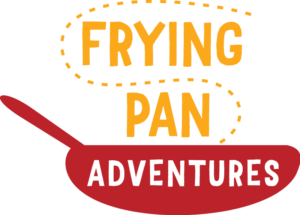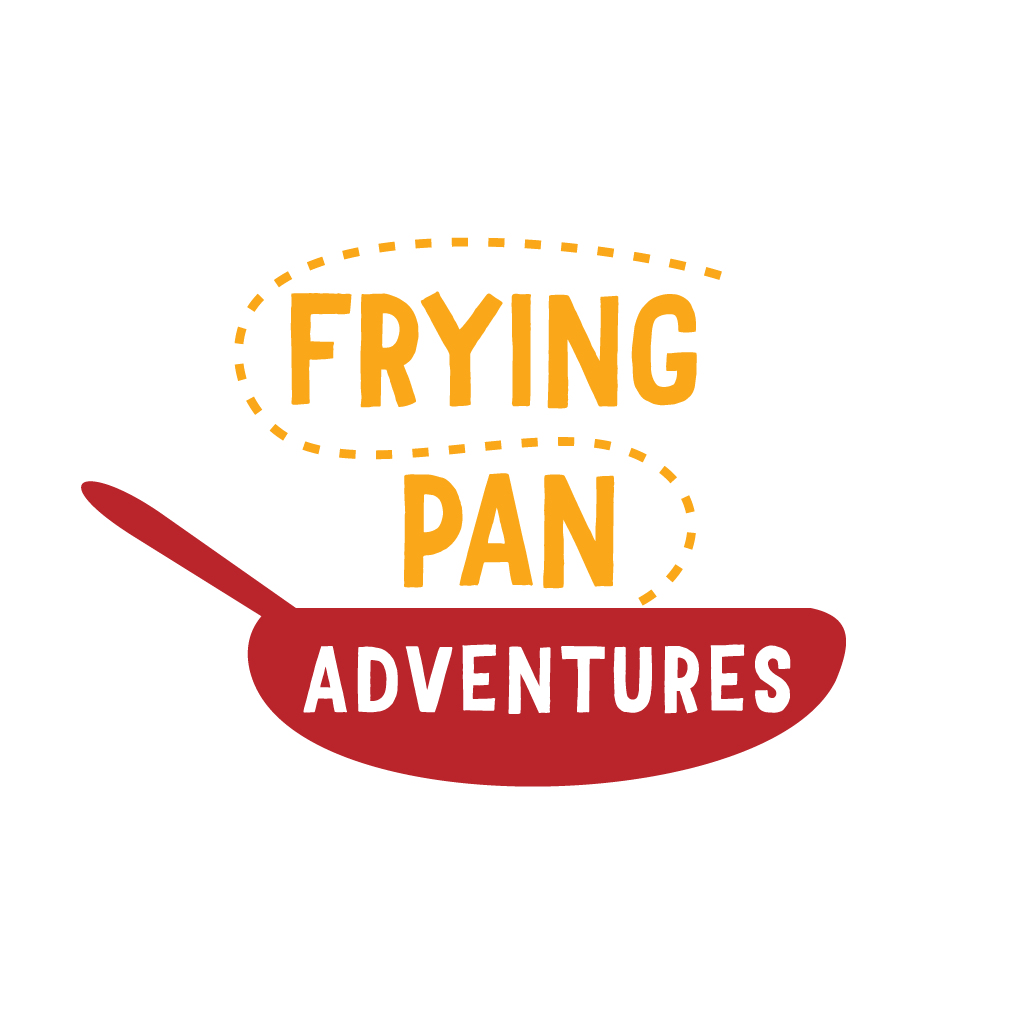From Kimchi to Kuksu, we share the delicious findings from our Korean-Uzbek food tour.
One of our most surprising discoveries while eating through restaurants in Dubai was that Uzbek restaurants were serving Korean dishes like Kimchi, Kuksi and Spicy Korean Chicken! We eventually found this topic so rich in both flavour and history that we dedicated an entire Korean-Uzbek food tour to exploring it with the community here in Dubai.
We called on our two teammates who led this food tour—our culture-curious Tour Guide Nahla Tabbaa and food-sleuth Eating Designer Mufaddal Husein—to help us get to the bottom of this mystery. We ordered the Korean dishes at Koreana Restaurant and their counterparts at UZB Avenue (both in Barsha) on our limited edition Korean-Uzbek food tour. We also visited our favourite Korean grocery store, 1004 Gourmet, which stocks everything from authentic Kimchi to ready-made packs of Tteokbokki (described in the post below!)
Read on for the list of similar dishes and let us know which versions you prefer over social media via Facebook, Instagram or Twitter.
Want more of our scrumptious podcast episodes? Feast on our main podcast page here!
Spotify (available on AppStore and Google Play) | Google Play Music (currently supported only for listeners in US/Canada) | Anghami
1. Korean Kimchi vs. Uzbek Kimchi
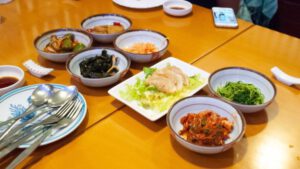
Banchan with Cabbage Kimchi (lower right) and Mandu Dumplings at Koreana Restaurant
Korean Kimchi is made from tall Chinese cabbage that is salted, then drained, coated in gochujang chili paste and left to ferment (traditionally underground in large earthenware pots). It can be served at meals as is but is also added to pancakes and stews.
Uzbek-style Kimchi is made with round cabbage, carrots, garlic and chili flakes and has a more pickled flavour that’s not too heavy on funky fermented flavours.
Listen to the podcast (or read the transcript) to learn of an unusual pairing with this kimchi that’s a favourite in Uzbekistan for a light afternoon lunch.
2. Cold Noodle Soups: Korean Mul Naengmyeon vs. Uzbek Kuksi
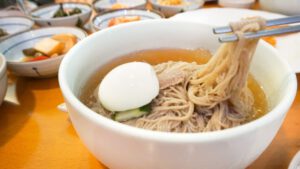
Mul Naengmyeon (Cold Buckwheat Noodles) at Koreana Restaurant
Mul Naengmyeon is a popular summer-time Korean dish of long buckwheat noodles topped with julienned Korean pear, cucumber, radish and sliced beef served with an icy slush of beef broth and pear juice which is poured over the noodles just before eating. The dish originated in what is now North Korea, particularly Pyongyang.
Uzbek Kuksi are similarly long and thin noodles that arent as chewy since they are made with wheat, served in a chilled (but not slushy) beef and tomato broth, topped with julienned beef, cucumbers, pickles and julienned egg omelette with a distinct taste of dill.
Nahla talks about the contrasts between the two and her preferred version on the show (and in the transcript).
3. Hot Noodle Soups: Korean Kal Guksu vs. Uzbek Lagman
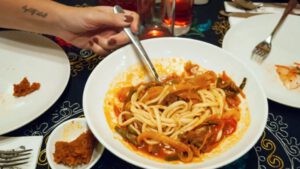
Lagman Noodles at UZB Avenue Restaurant
Korean Kal Guksu features fresh vegetables cooked with smooth, thick (yet tender) wheat-flour noodles in a broth flavoured with soybean paste that lends an umami boost to its clean and pure flavours.
Uzbek Lagman are thick and chewy hand-pulled noodles that evolved from the more famous yet thinner and more delicate Chinese Lamian noodles. These rustic noodles are served with diced beef and peppers in a hearty beef broth flavoured with tomato and Central Asian spices like mild paprika, coriander and cumin and are said to be Uzbekistan’s most popular dish after Plov (find a home recipe for Azerbaijani Plov here.)
Mufaddal talk’s about the history of Lagman on the podcast (or read about it in the transcript)
4. Dumplings: Korean Mandu vs. Uzbek Manti
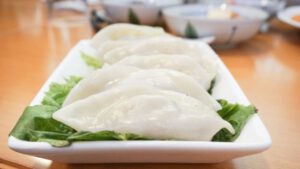
Steamed Mandu Dumplings at Koreana Restaurant
The Mandu dumplings at Koreana Restaurant have a distinctly home-made feel to them and can be steamed or pan-fried as preferred and served with a light soy sauce.
On the other hand, Uzbek Manti are larger, almost fist-sized dumplings, usually stuffed with a chopped beef and onion filling (or pumpkin as a vegetarian option) and served with sour cream, or optionally a chili sauce.
On the podcast (and in the transcript), we discuss the possible reason why dumplings across Asia, from Turkey and Afghanistan all the way to China and Korea, have surprisingly similar names: manti, mantu, mantou, mandu, etc.
5. Korean Tteokbokki, Buldak vs. Uzbek Spicy Korean Chicken
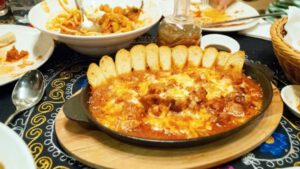
Spicy Korean Chicken at UZB Avenue Restaurant
Tteok are Korean glutinous rice cakes that are braised with gochujang chilli paste to make a traditional comfort food called Tteokbokki, that also has a more modern take with chicken called Buldak.
Buldak literally translates to ‘fire-chicken’ and is a popular fast-food for a night out about town. The cheese-pull social media trend has made grilled and melted cheese an almost compulsory topping, which also helps to deal with the ridiculous level of heat true to the dish’s name.
The popularity of Koryo Saram dishes and more recently developed cooperation with South Korea has inspired Uzbek cooks to adapt Korean Buldak to suit their local palettes.
While the visual aesthetic is close enough, find out how close this version is to the original and what it reminds Mufaddal on the podcast (or in the transcript).
Not a fan of audio? Here’s the show transcript for you to read!
Arva: This show is brought to you by Dubai’s most gluttonous food tour company, Frying Pan adventures and you’re listening to Deep Fried. Hey there, I’m your host, Arva Ahmed and thanks for joining me on the show that’s inspired by flavors of the East. This podcast celebrates the old-world flavors that we as storytellers, content creators and food tour guides with Frying Pan Adventures have discovered in Dubai.
And one of those discoveries that still blows my mind, even till today, is this very unexpected, curious connection between some of the foods of Uzbekistan and those of Korea. In fact, our team here at Frying Pan Adventures dedicated an entire tour to just exploring that surprising culinary link and figuring out why. Why on earth would these two cultures have almost mirror images of some dishes at each of their tables?
Is this a product of the historic silk road or is there something else going on? So, to answer that question, on this episode, we’re bringing back to the table the two guides who led this is Uzbeki-Korean food tour on the ground here in the city. The Jordanian-Bangladeshi artist, curator, food tour guide, and home cook extraordinaire Nahla Tabbaa and the Indian food detective, walking culinary encyclopedia, lover of offal and our eating designer Mufaddal Husein.
Hey Nahla & Mufaddal! Thanks for joining me today.
Nahla: Hi! Great to be here.
Mufaddal: Hey Arva, I’m so excited to be talking about this topic!
Arva: Well, both of you have actually done an entire tour and a whole lot of research dedicated to this topic, as in why there’s a connection between Uzbeki and Korean food. And I remember walking away from that tour with my head just buzzing with all this information. So, I want us to get into all of that history that I know you both know but first, let’s just talk food.
So what dish were each of you most surprised by when you saw it being replayed across both cuisines and, and take us through what made them similar but also what some of the differences were? Okay so, Mufaddal why don’t you get us started?
Korean Kimchi vs. Uzbek Kimchi
Mufaddal: Yeah so, with the most Korean dish that you know – Kimchi. I was just so surprised to see this on the menu at the Uzbeki restaurant that I visited first. And I’m wondering while I’m looking at the menu, why, why does an Uzbek restaurant that has all these Uzbek dishes on the menu, why is there just Kimchi?
And then as I peruse the menu, even closer, I saw that there were a couple more Korean dishes and it just didn’t make any sense to me. So, I had to order Kimchi at an Uzbek restaurant and just find out what’s going on over here. Well, it is similar to Korean Kimchi in that it’s made with cabbage and there are root vegetables like radish in it. Unlike Korean Kimchi, it also has carrots in it.
It’s milder in flavor. It’s got more of that pickled flavor that you associate with maybe Russian or Persian pickles.
Nahla: Like a Sauerkraut.
Mufaddal: Yeah, kind of like that. A more vegetal taste rather than, rather than the fermented taste or that funky flavor that you expect from Kimchi.
Arva: Right.
Mufaddal: So more vinegary, milder, as opposed to more fermented and spicy or punch you in the face Kimchi.
Nahla: So interestingly, I had seen it a lot in markets across Georgia and Armenia as well and that was very perplexing to me. Like, yes, you’ll find all kinds of things pickled but then an entire stall would be dedicated to Kimchi.
Arva: Wow! And even in Georgia and Armenia, it was cabbage and carrots or just straight-up Korean Kimchi?
Nahla: It was cabbage and carrots, I believe.
Arva: That’s so interesting to have and, okay, so is it eaten in the same way? Because in Korea it’s not only just had as a condiment, but they actually incorporate it in some of their dishes. Am I right? So is that the same with Uzbeki food?
Mufaddal: As far as I know, from what I’ve read up on it, it’s eaten mainly as a salad or it might be eaten as part of a light lunch with naan, which I was completely blown away by.
Nahla: That blew my mind too.
Arva: Wait, wait, wait, let’s back up. Okay wait, so you are going to have your kimchi with your naan?
Mufaddal: Yeah. So, so this fluffy, crisp on the outside, pillowy on the inside Uzbek naan being eaten with Kimchi. So, bread and pickles is kind of, eaten across a lot of cultures as part of a rustic meal. Like a farmer’s lunchtime meal in the field. So yeah, it kind of makes sense because Uzbekistan is this rustic place and you’re eating pickles. But pickles and Kimchi, it’s not exactly the same, right? But the Koreans use Kimchi in their, in Kimchi pancakes, Kimchijeon, I think…
Nahla: Stews
Mufaddal: Stews, yeah. I was about to say that. Thanks, Nahla.
Nahla: Stir-fried rice too…
Mufaddal: There you go.
Nahla: So, I’ll get into the history around that a little bit later, but it was also to do with the fact that Koreans based in ex-Soviet countries didn’t have access to rice in the same way. And so, bread became that staple instead.
Arva: That’s so fascinating. I wonder how the Koreans feel about that. Seeing there, a version of their Kimchi infused with carrots and then being eaten with naan. I know on the tour we debated a lot about authenticity versus evolution of dishes. And of course, in this case, we’ll like you said Nahla, we’ll get into the history later. Sometimes it’s just a question of necessity. And so, people are not sitting there having those existential debates that we can have now in hindsight. But okay so, Kimchi, Kimchi with naan that’s our first one. Nahla, what did you find most surprising?
Cold Noodle Soups: Korean Mul Naengmyeon vs. Uzbek Kuksi
Nahla: Oh, my God! My favorite, absolute favorite dish is called Kuksi at an Uzbeki restaurant, however, in a Korean restaurant, Mufaddal you’re going to need to step in here and help me pronounce,
Mufaddal: Do you want to say it? Go ahead. Give it a try.
Nahla: You do it. No, come on.
Arva: I want to hear Nahla’s version of it.
Mufaddal: No, come on.
Nahla: Oh my gosh!
Mufaddal: Yeah, we’ve got to, we’ve got to hear your version of it.
Nahla: Well, well, I’ll, I’ll have Mufaddal go first. Mufaddal is the scapegoat, Guinea pig and…
Arva: Yeah, because we don’t want to offend both the Koreans and the Uzbekis.
Nahla: Exactly!
Arva: Mufaddal, tell us what it is?
Mufaddal: So the Korean cold noodle soup, which is actually a specialty from North Korea. It’s called Mul Naengmyeon.
Nahla: That’s exactly what I was going to say. So, that’s what it is.
Arva: Alright.
Nahla: Ok, anyway.
Mufaddal: And there’s a more modern version called Bimbim Naengmyeon, which is kind of like a Bibimbap. So there’s this, there’s a more modern version of that as well, but the traditional one is Mul Naengmyeon.
Nahla: There you go listeners, just hear Mufaddal on the pronunciation. But just to get into the dish and diverge from this embarrassing situation. They are buckwheat noodles that are served in this cold broth. So essentially, it’s the summer dish that North Korea, as Mufaddal said, developed. And it’s this broth of both beef and pear juice combined. This broth is then frozen into a slush and you will have the noodles served with the broth and then it’s topped with radishes and extra beef as well. So, we had our version at Koreana where Mrs. Kim was speaking about it and explaining it to us. But when we revealed to her that we were going to try Kuksi at an Uzbeki restaurant. Oh my God, her reaction was something I’ll never forget because
Arva: I remember that. Yeah, walk us through that.
Nahla: Yeah.
Mufaddal: I wish she was here. I wish we had Mrs. Kim talking to us.
Nahla: So, she complained a lot about the fact that she has guests from Russia coming in asking for Kuksi and are never happy with what she serves up to them. And she’s like, that’s because they serve tomato ketchup in theirs and I refuse to do the same thing and she was so fixated on this idea of how offended she was.
Mufaddal: She was livid.
Nahla: Yeah, she was, she was really livid by the tomato ketchup. And here’s the thing, it’s, it’s simply an evolution. When we went through the history and explained to her that this is a result of Koreans that had migrated or were forced to live in certain places and had to adapt this dish. Do you find that it’s Korean? Yes or no? And she’s like, absolutely not. Now Kuksi and, and Uzbeki restaurants, I have to say Arva, you and I tried both that, that first time.
Arva: Yes.
Nahla: The one that we had at UZB Avenue is…
Arva: Which is the Uzbeki restaurant?
Nahla: Yes, exactly. The Uzbeki restaurant. It has a broth of both the beef and the pear juice, but then they do add tomatoes to it. They add some dill as well. And I found that one incredibly refreshing. That, that really took it to another level for me. So, if I have to make a choice, I hate to say this, I will never say this to Mrs. Kim, but I do love that Uzbeki Korean version of that.
Arva: Not winning any Korean friends today are you? Didn’t get the name of the dish right and you just picked the Uzbeki version of the dish.
Mufaddal: But that name Kuksi, it is actually a very Korean name because Guksu is the hot noodle soup that you can order at Mrs. Kim’s restaurant. And if you go and order Guksu you’ll end up getting the hot noodle soup. But I think, both, the Kuksi at the Uzbeki restaurants as well as the Naengmyeon that you are getting at the Korean restaurants are so perfect in this heat that we’re experiencing right now. Nothing better for this heat.
Arva: Remind me, which one actually had ice cubes in it. Do both of them have because I remember one of them does.
Mufaddal: No.
Nahla: No.
Arva: I think that both of them do have ice cubes in them.
Nahla: Both, ideally, need to be served as cold as possible. So, it’s almost like a slush or a sorbet that you’re having with noodles.
Arva: Yeah, which is so unexpected. You just don’t think of having icy broth with your noodles. Alright, incredible. While all of this talk is taking me right back to that delicious evening when you both led the tour and we ordered the same sets of dishes at each of the two restaurants, the Korean one, which was Koreana and the Uzbek which was UZB Avenue. And I loved how you both just slowly, gradually pulled apart why those similarities came to be between the two cultures. Which brings us to history. Both of you have been alluding to bits and bobs. We are going to rewind back in time to explore what caused the link. But first, let’s take a quick break.
Arva: Welcome back to Deep Fried. We are chatting about the surprising link between Uzbeki and Korean food on this episode with Nahla Tabbaa and Mufaddal Husein, who actually led a food tour on the ground here in Dubai, comparing dishes that were replicated across Uzbeki and Korean dinner tables. Now we’ve set the stage with two examples of dishes that are enjoyed in both countries – Kimchi as well as the cold noodle soup that is called Kuk Su in Uzbeki. And Mufaddal, give us the Korean name again?
Mufaddal: Mul Naengmyeon.
Dumplings: Korean Mandu vs. Uzbek Manti
Arva: Yes, what he said. So, let’s now get into why there’s a link. So Mufaddal, since you are our walking culinary encyclopedia, do you want to start breaking this down for us?
Mufaddal: Yeah. So, when I was sitting there in the restaurant, I’m wondering, why aren’t there Chinese dishes on the menu? Why Korean of all these places? My first thought immediately was, okay, Uzbekistan: Samarkand, Bukhara, all of these amazing Silk Road cities. Maybe it has to do something with that? Because there are other noodle dishes on the menu. And there are other dishes like dumplings that you find all across Asia. So…
Arva: Absolutely! That’s what I thought. I thought it was the Silk Road first off.
Mufaddal: Yeah, so, but then you start thinking that the Silk Road kind of ends in China and you’ve got the huge Mongolian desert sitting between the Stans and Korea and Uzbekistan is one of the only two doubly landlocked countries in the world. Korea is half a continent away on the edge of the Pacific Ocean. So it just, it doesn’t quite add up. There’s something more going on here.
Although having said that, some of the names like Korean dumplings are called Mandu and in Uzbekistan, there, the larger dumplings that they have are called Manti. And then you have other dumpling variations called Mantu as well. So you’re seeing that there is some link but you’re seeing that these names have changed over time and over the ages. Whereas Kimchi is definitely written down as Kimchi. There’s no change. There’s no alteration in the name. So there must be something more modern at play over here.
Yeah, so that’s when we started digging into this a little deeper and I’ll let Nahla continue on where. What we found.
Arva: Ooh…alright, so Nahla?
Nahla: Yeah, I mean this is a pretty painful story. It happened between the 1860s, up until 1937. So, there were a few migrations from North Korea into ex-Soviet countries and Russia. And this also included Uzbekistan and Kazakhstan. Now, the Japanese had occupied Korea, for example, before the Second World War and many of them had fled to Russia. Now in Russia, Stalin grew very suspicious of the growing Koryo Saram community. So, this is what they were kind of nicknamed over there.
He saw them to be Japanese spies. And again, because culturally, they were just such a close-knit community. There was a time when there were newspapers printed in Korean. The language and the preservation of the culture was so strong. Stalin then uprooted those people from Russia and deposited them in the emptiest, most vast parts of central Asia with no shelter and no food. And it was Kazakhstan and Uzbekistan that kind of provided that shelter and that support, particularly nomads. And they then had to kind of re-earn this reputation by working very hard.
They worked the lands in agriculture and slowly started to build themselves up again. And this is where it gets interesting when it comes to transitions, for example, between rice and bread. So, so that is one thing that the Koryo Saram people had to adapt to But, even before cabbage was being planted in these arid lands that was the reason for using carrots to make kimchi as opposed to cabbage, right.
Arva: Okay.
Nahla: Yeah.
Arva: So, it really arises out of what is available, which makes so much sense.
Nahla: Exactly. Yeah. And we can definitely share in our show notes some documentaries that we came across. But it really fascinated me because when you look at the Koryo Saram community today, they are literally this, yeah, this combination of preserving Korean culture, but also are very much a part of the ex-Soviet countries as well. So, the way their weddings take place, for example. We debated this idea of whether eating with chopsticks was still a thing or was, was that sort of left behind as a practice.
Arva: And do they still eat with chopsticks?
Nahla: From what I saw and recalled in the documentaries not, not necessarily.
Arva: Ah okay. I, I forget, at UZB Avenue do they serve the food with chopsticks? I can’t remember chopsticks being…
Nahla: No.
Arva: There we go.
Mufaddal: No, not at all. I think with forks, and spoons for the soups. And I think that transition to bread had actually already happened earlier when the Koreans had migrated to Russia and there is documented evidence of Koreans changing because rice doesn’t grow there, as they moved further North up from North Korea into Russia, rice doesn’t grow there.
So they literally had to already start using what was at hand and that was bread. And, just like Nahla said that story is just so inspiring to see how a culture has to, essentially, plant their roots again and adapt to the difficulties that they had and their reputation has become one of, of people who’ve overcome severe challenges in these Soviet nations where they’re known as the people who brought agriculture to Central Asia. And not just cabbages and carrots, but even cash crops, like, fruits, like apples and stuff like that.
Nahla: Yeah.
Mufaddal: And I remember Nahla was telling me about this, that in the markets of Moscow, it was these Korean farmers who would take their crops of apples and like, you know, they started selling them.
Nahla: Watermelons as well.
Mufaddal: Watermelons. There you go. We want to talk about that, Nahla?
Nahla: I don’t have more to add to that.
Mufaddal: Yeah.
Arva: But it’s always Nahla who reminds me sometimes, you know, about not overly romanticizing some of these dark elements of history because, of course, when you are left with no choice you do end up having to be resourceful and now we can kind of turn around and say ‘Oh, how innovative and how resilient’ and whatever else these people were. It’s very unfortunate that they had to have been displaced all the way from Korea into the Soviet Union and, and then so on.
Nahla: But here’s the thing, the presence of their foods in restaurants or in markets and, and being such a strong part of what is eaten in Russia almost as an everyday menu is really that mark of a success and a presence.
Arva: Yeah.
Nahla: So that part can definitely be celebrated for sure.
Arva: Yeah.
Now not all of the connection is entirely due to the Koryo Saram population. I know both of you sort of alluded to the fact, or maybe it was Mufaddal who said there are elements of it that might have been Silk Road.
So, can you give me, other than Mantu, another example of a dish that has come to be not because of the Koryo Saram community? But it’s still connection a that’s happened over time.
Lagman
Mufaddal: Particularly I think Lagman, which I think best exemplifies some of the more older connections because Lagman are these hand-pulled noodles in a beef broth. But we know that definitely that these noodles are related to Langzhou Lamian that you’ve covered in our previous podcast episode.
Arva: Yes and Xini had shared, so on that episode, Xini had shared that it’s always the Chinese Muslim restaurants that are making these noodles. So now this connection is starting to make even more sense.
Mufaddal: Yes, because there’s very well documented evidence of Central Asian and Persian merchants living in Chinese cities at the end of the Silk Road. So, they brought over all these spices from the Middle East and it kind of mixed with the finesse of noodle-making that had developed in China. And that’s how noodle-making kind of spread towards Central Asia.
And you have, I think, a couple of noodle dishes on the menu at the Uzbeki restaurants but there are differences and there’s an evolution. Like Uzbeki Lagman compared to the fine strands of LaMian that you can have in a very simple broth. Lagman is actually quite rustic. It’s this thick chewy noodle as opposed to the fine, wheat noodles.
Arva: Silky noodle.
Mufaddal: Silky, exactly. That’s the word I was looking for, the fine silky Lamian. Lagman is actually chewy and it’s got its own sort of heartiness and that broth is made with cumin and coriander, paprika, all these other spices that you wouldn’t necessarily use in Chinese cooking. And that’s the dish that, I think, best exemplifies the transition of dishes down the Silk Road.
Arva: And it’s called Lagman in both cultures?
Mufaddal: No, Koreans don’t have Lagman, though. I think the presence of Lagman and other noodle dishes kind of enabled in a way this transition of Naengmyeon to Kuksi in the Uzbek menu. I think it made it more acceptable and more easier.
So, the same way that Koreans adopted bread, more easily, because they were kind of used to it in Russia. I think that Kuksi being this kind of very popular summer dish in Uzbekistan is also because there were already noodles there and Uzbek Kuksi actually does not have the buckwheat noodles that Nahla was talking about, it instead uses wheat noodles which is way more common.
Arva: Okay, got it.
Mufaddal: Yeah, so I also wanted to add another thing about dumplings. Dumplings, like Mantu, in Korea weren’t known until the Mongol invasion. And it’s the Mongol invasion that spread these dumplings around Asia. So, meat-eating until that time had actually dwindled quite a lot in Korea. And the reason that you have a Banchan in Korea is because, it was to give people some enthusiasm for vegetarian food. And that’s why you had all of these different Banchan dishes come up as part of the Buddhist culture that had taken hold of Korea before the Mongol invasion.
Arva: Oh my God, wait! Okay, so for people who don’t know what Banchan is?
Mufaddal: So Banchan…
Arva: define…
Mufaddal: So Banchan, so Banchan are these little small plates of snacks and starters and pickles and salad. And Kimchi is usually part of Banchan that you would be served at any at, at a Korean restaurant worth it’s salt. Like, for example at Koreana, where we went and you get at least four to six different Banchan on your table before you’ve even ordered.
Arva: Love that! You should be served food right when you get there. I love that.
Mufaddal: So yeah, it’s the Banchan, and Kimchi evolved as part of Banchan dishes to enjoy vegetarian food. And then you had the Mongols bring in their meat-filled dumplings which were actually not a part of Korean cuisine until then.
Arva: Wow! There’s all of these layers of connections if you just kind of pull apart the dishes. Fantastic.
Mufaddal: Yeah.
Arva: I also remember this really fun dish that you both had ordered on the tour which had cheese in it. So, we can’t end the episode without a cheesy dish. Tell us what that was.
Korean Tteokbokki, Buldak vs. Uzbek Spicy Korean Chicken
Nahla: So, Mufaddal if you like, I can talk about Tteokbokki and then you can talk about the Korean chicken with cheese, where when we asked them what was in it they were like Korean spices or it’s spicy?
Mufaddal: It’s spicy, I think that’s what they said. So, yeah, actually, actually there is a Korean dish which is actually like that, but Nahla why don’t, why don’t you talk about Tteokbokki first and I’ll get into how it’s transformed in Uzbekistan.
Arva: …into cheesy chicken at the Uzbeki restaurant. Okay, go for it.
Nahla: Yeah, absolutely.
Mufaddal: Yes, into the cheesy chicken dish.
Nahla: Tteokbokki is so good. It’s like a mac and cheese. And when we were doing research on this dish one of my friends, Batool, who’d been to Korea a few times told me it was the kind of dish she could buy it on the street, folded in paper. And it was like, the Mac and cheese of Korea.
So, they are rice cakes that are cooked in this anchovy and kelp stock with Gochujang—which is a Korean chili paste—fish cakes, you can have some spring onions added and, you know, melted cheese is one of those things that has just made its way to so many foods and just completely amplified them that, yes, you do get the stringiest cheese sitting on top of that. And that’s how we had it served at Koreana. I mean, you can opt for no cheese but who on earth would want to do that?
Arva: Yeah. Why would that, that kind of defeats the whole purpose.
Nahla: Exactly.
Mufaddal: Well, traditionally, Tteokbokki comes with half a boiled egg which you’re supposed to eat first. And that’s supposed to, like, coat your stomach lining for, for wimps like me and Arva who can’t bear our spiciness.
Arva: Spicy!
Mufaddal: So, yeah. So, you eat the egg yolk first and that’s supposed to coat your stomach lining and makes you able to take that Gochujang hit. Actually, cheese is apparently not traditional on this dish. Mrs. Kim was like, okay, I’ll put it if you want but it’s not supposed to be there.
Arva: What?! That’s like telling us Santa Claus doesn’t exist. Don’t do this.
Nahla: Yeah, exactly.
Mufaddal: Yeah, but I’ll say this, I agree. I agree with both of you all that the cheese version is just divine. It’s like spicy mac and cheese but cheesier.
Arva: Come on. Everything’s better with cheese. Cheese is better with cheese.
Mufaddal: Absolutely!
Arva: What kind of cheese do they use? Is it just like regular cheddar? I think it’s just regular cheddar.
Nahla: Processed mozzarella or cheddar cheese works. Absolutely.
Mufaddal: I mean you need processed cheese for this. Like that’s going to be the best thing.
Nahla: You can also buy these rice cakes in the frozen food section of 1004 Gourmet, just as a heads up in case you want to try this at home
Mufaddal: I think you can buy the whole…
Nahla: …combination as well and just microwave it. Yeah, that’s possible too.
Mufaddal: I don’t know whether it’s microwavable or you need to cook it or what. But look for the packet which has a girl with a tear on her face.
Nahla: Yes!
Mufaddal: Do you remember that Nahla, that packet? That was amazing. it’s telling you from the start that you’re going to be crying but also happy at the same time. I mean, at least they’re honest about it.
Arva: Awesome. Okay, so that’s the Korean version. Tell us about the Uzbeki version.
Mufaddal: So, the Uzbek menu has on it a dish called, quite plainly, ‘Spicy Korean Chicken’ and…
Arva: Oh, my goodness!
Mufaddal: I was like you don’t have a name for it? And they are like no, it’s ‘Spicy Korean Chicken.’
Arva: And what goes into it?
Nahla: ..and that’s the thing. We’re so specific because when we have to do our research at restaurants, we’re like, okay, what’s it made from? What are the ingredients?
Mufaddal: …tell us the name, yeah.
Nahla: How’d you make it? What are the spices? We got a very simple, no-frills answer which I will never forget.
Mufaddal: …so, when Nahla asks the waiter, “so what makes this Korean?”
He just looks at us as if it’s obvious. He’s like, “yeah, it’s spicy so it’s Korean,” right?
Yeah and we were like, “what kind of spices go into it?”
And he’s like, “well there’s chili powder and there’s coriander and there’s cumin.”
And we’re like, “so what’s Korean about it?”
And again, he just looks, at us and he’s like, “it’s spicy.” And that was it, but…
Arva: Oh, dear God!
Nahla: So maybe, maybe it’s the cheese that was the commonality in that case. Like there was no evidence of Gochujang paste in there. That’s not what we tasted.
Mufaddal: Yeah, no. But it was this red dish and it was…
Nahla: Yeah…
Mufaddal: …well, it wasn’t Korean-spicy but it was mildly spiced. It did have some amount of chili in it. It had this red sauce and they had the aesthetic of the dish down. It was served in this sizzling plate, pieces of chicken, and you have the cheese on top…
Arva: But there’s no chicken in the Korean version. There’s these…
Mufaddal: So, there is…
Arva: Did you say they were the fish cakes?
Mufaddal: There was. So, Tteokbokki doesn’t have chicken. Tteokbokki has rice cakes and fish cake, but…
Arva: Wait it has both rice cakes and fishcakes?
Nahla: Yes.
Mufaddal: There you go, but there is a Korean dish. There is a Korean dish which is very, very similar and it’s called Buldak.
‘Bul’ is fire in Korean and ‘dak’ is chicken. Don’t get confused, dak is chicken!
So Buldak, which Korean cooking YouTube sensation, Maangchi, describes very much in her own words as “Korean Spicy Chicken”—so there you go, the Uzbeks aren’t wrong—is that absolutely similar dish. That’s the dish which is actually most similar…
Arva: And that has cheese as well?
Mufaddal: Yes, very much so.
And it also has the rice cake that Tteokbokki has and the Uzbeks get one thing very similar is, Nahla do you remember how it was served?
On the side of that spicy Korean dish, they had those slices of bread on the side, which you could use to scoop up the cheesy chicken. Well, the shape of the bread is exactly the shape of the sliced Tteokbokki that you will get in 1004 Gourmet.
It’s the same, like yeah, cylindrical cross-sections, sliced at an angle. So they’re trying very hard, but they’re catering to a completely different audience. So it is adapted very much so for Uzbek and Russian tastes, I guess.
Arva: I guess. I think I remember someone and I don’t know who, whether it was one of the guests or if it was one of you, actually describing it as butter chicken with cheese on top.
Nahla: Oh, yeah. I do remember that.
Mufaddal: That was me, that was me!
Arva: Yeah, I think that’s a good way of describing how it is for someone who has not tasted it.
Mufaddal: Yeah.
But I think, it’s great to talk about all of these dishes but really the way to do it is to go and order these dishes for yourself and try them out
Nahla: Yeah.
Mufaddal: and see what you think. There’s no better way to do it.
Arva: Hundred percent agree.
So now, if people are listening in from another part of the world and they’ve got these two cuisines represented in their backyard, they’ve got to do exactly that. Go out hunt for that delicious connection that we found here in the city, in Dubai.
Guys, I loved that you both brought alive one of my favorite tours on this podcast. Thank you so much for joining us and we will make sure to share the comparative list of dishes that you both spoke about as well as the show transcript on our blog at fryingpanadventures.com/blog.
And we would also love to connect with you our dear listener over social at Frying Pan Adventures on Instagram and Facebook and @FryingPanTours on Twitter.
And if you’re looking for Mufaddal and Nahla over Instagram, you can find them @mufaddal.husein and @nahlatabaa and we’ll make sure to share those handles in our show notes.
As always, if you enjoyed listening to Deep Fried please rate, review and share the show with your friends.
And before we say goodbye, I’m going to leave you with a quote that resonates with me when I think about the Koryo Saram community and how they were displaced, but they managed to rekindle their cuisine and culture miles and miles away from their homeland. And they really adapted it to a different world. These are words by none other than Mahatma Gandhi:
“A nation’s culture resides in the hearts and in the soul of its people.”

Arva Ahmed is the co-founder of Frying Pan Adventures, Dubai’s first food tour company, and a celebrated food explorer known for uncovering Dubai’s hidden culinary gems. Her expertise in the city’s diverse food scene has been featured in prominent publications such as CNN, Khaleej Times, BBC Travel, The Sun, The Independent and countless more. She also hosts Ditch the Silver on YouTube. Through her immersive tours and storytelling, Arva brings Dubai’s rich flavors and vibrant cultures to life.
